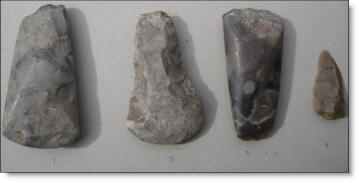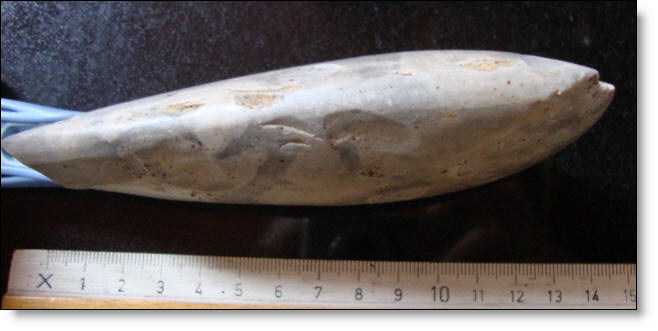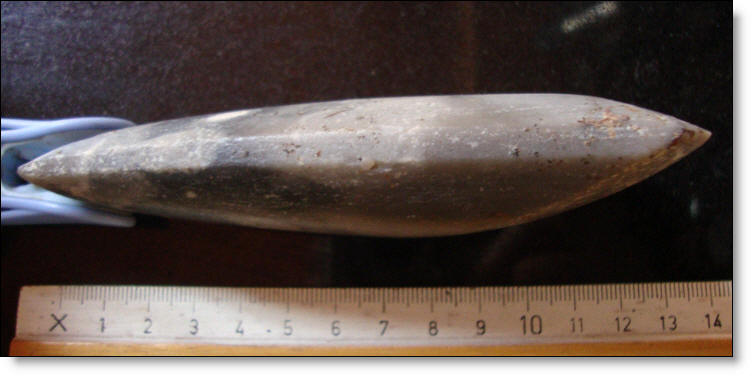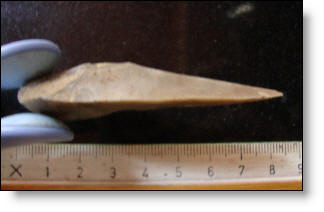molash ~ once a Neolithic settlement?

In September 2010 I started to dig out the foundation for a concrete path
in my garden. As I was digging I
noticed an unusual piece of flint. Picking it up I could see immediately it was
axe shaped; I cleaned it off and found it was a beautifully polished piece of
flint, nearly six inches long, and which could not have been accidentally formed.
An Internet search showed that it might be a
Neolithic, or
New Stone Age, axe
(Axe 1). That is, at least 4000 years old! I sent a picture of it to a
friend who is a trained archaeologist - Friederike Hammer. Friederike also
thought it was Neolithic (c. 4000 - 2000 B.C.). She suggested I take it to the Canterbury archaeological team, which I did, and they confirmed that it was
probably Neolithic but a "one off" - dropped by a Stone Age man - as the
majority of such finds tend to be.
From then on I dug a little bit more carefully (!) but did not find anything except a nice small blade (Blade) obviously used for cutting or skinning. However, a few days later I looked more closely at the site of the first axe and found two more axe heads! (Axes 2 and 3). All three axes lay very close to each other but the last two were actually under the concrete foundation of my shed. This was getting serious. I contacted Friederike and soon after she came to Molash to help me dig and sort more methodically. We discovered several fragments of flint that could well have been flakes from a stone tool production. We did not find anything more significant (so far).

(All photographs Copyright © Paul Brewin, all rights reserved, 2010)
Neolithic polished stone axes
These were made in their thousands all over Britain and used for wood clearing as Neolithic man began to settle and grow crops and graze cattle. More wood clearing was done than at any other time in our history. Polished axes were not produced until late Neolithic times (4000 to 5000 years ago) and made the axe stronger and easier to cut wood. However, highly polished and worked axes may have been used for other purposes - trade, ceremonies, gifts etc. The axes I found appear not to have been used so they may come into this category.
Molash is on a flint hill - if one walks the fields around here, as local people know, there are billions of flint stones, fragments, chips, etc. The Norman church at the end of Church Lane is built of flint. So it seems highly probable that the area was used for a very long time for flint work and production. There is a major Neolithic site quite close by at Chilham - Julliberrie's Grave - a Neolithic long barrow and sites have also been found in Kings Wood.
(I have reported the find to the archaeological finds officer for Kent).
Paul Brewin, Molash, Canterbury
Neolithic flint axes F1-F3 and pointed Flake F4

Axe 1 - F1 - Face 1

Axe 1 - F1 - Face 2

Measurements: Length: 13cm, width: top (blade): 6.5cm, bottom: 4cm, thickness (at broadest point): 3cm
Weight: 303gm
Mottled grey flint stone.
Method of discovery: Digging out a foundation for a path
General land use: Garden
Date of discovery: Wednesday 1st September 2010
The blade edge is almost perfect with a small piece missing (top
photo. bottom right edge).
As can be seen the but has some damage with pieces missing. The long edges have
been worked and are almost flat - about 5mm wide. The main body has some
chipping but is, on the whole, very good and highly polished.
Edge views:


Axe 2 - F2 - Face 1

Axe 2 - F2 - Face 2

Measurements: Length: 12cm, width: top (blade): 7cm, bottom: 2.7cm, thickness (at broadest point): 2.5cm
Weight: 207gm
Mottled grey flint stone, with some "pattern" on face 1.
Method of discovery: Digging out a foundation for a path
General land use: Garden
Date of discovery: Wednesday 5th September 2010
This is a much rougher axe but the blade edge is very good. However, the body looks like it was shaped more, with more work to be done.
Edge views


Axe 3 - F3 - Face 1

Axe 3 - F3 - Face 2

Measurements: Length: 12cm, width: top (blade): 5.5cm, bottom: 3.5cm, thickness (at broadest point): 2.5cm
Weight: 210gm
Mottled darker grey flint stone.
Method of discovery: Digging out a foundation for a path
General land use: Garden
Date of discovery: Wednesday 5th September 2010
The blade looks like it was being worked on, it is not finished. The body is very good and highly polished. Face 1 is bevelled towards the blade The edges are almost flat about 4mm across.
Edge views:


Blade - F4 - Faces 1 and 2


Blade edges


Measurements: Length: 7cm, width: 3.2cm, thickness (at broadest point): 1cm
Weight: 22gm
Brown/grey flint stone.
Method of discovery: Digging out a foundation for a path
General land use: Garden
Date of discovery: Wednesday 1st September 2010
This was almost certainly a cutting tool. It is finely made and very sharp. There is a small chip in the blade
Face 1 of the but is roughly made or damaged while face 2 is smooth.
Other pieces which need to be looked at by an expert:
